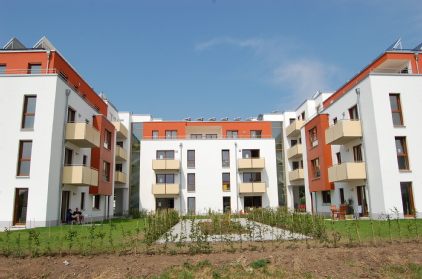

 Solar powered house Münster
Solar powered house Münster
Pluggit domestic ventilation important components in Münster’s first “climate protection estate�
A third of the total German energy consumed is used by the building sector. For this reason, North Rhine-Westphalia is aiming to further reduce CO2 emissions through so-called “climate protection estates�. The first “climate protection estate� in Münster was completed last year. Thanks to the way it is constructed, it is also simultaneously considered the largest solar home in Europe. The Pluggit domestic ventilation system forms one of the important integral system components.
35 freehold apartments, ranging in size between 50 and 140 m² in five buildings, have been constructed on the 4,000 m² site. Special feature: Here stands not only Münster’s first “climate protection estate� from the “100 climate protection estates in North Rhine-Westphalia� programme of the NRW Energy Agency, but rather also the largest domestic building in Europe, which harnesses most of the energy it needs from the sun.
Maximum 9 kg/m² CO2 emissions
Jörg Petzold from the leading architecture firm AJP Architects in Münster explains: “Many components are required so that a ‘climate protection estate’ can actually be made as part of a regenerative building project.� The following requirements are a must: Construction type as a passive house standard or as a three litre house, evidence of air-tightness of the building using a blower-door test, erection of the house facing south to a specific degree, construction of at least 30 flats or 20 homes as well as good transport links. “CO2 emissions have been set at a maximum of 9 kilogrammes per square metre per year,� continues Petzold.
Five components for a virtually zero energy house level
The climate protection estate “Solar house� in Münster almost reaches the standard of a zero energy house. Several components are decisive in this: A well heat-insulated building, triple-glazed windows, avoidance of thermal bridges, as well as the use of regenerative energy and a controlled domestic ventilation system. For this purpose, a Pluggit system was chosen - the technological market leader of this field.
Fresh air and minimal heat loss thanks to WRL
As specified in Germany Industry Standard (DIN) 1946-6, domestic ventilation systems must guarantee the minimum air exchange required in buildings. Following prior analysis and calculation, the required amount of air is simultaneously supplied and extracted from the individual rooms. In this way, manual window ventilation is rendered obsolete. Furthermore, thanks to the integrated heat recovery system colder air is warmed up by the warmer extracted air - a saving potential of ventilation heat demand of more than 60 percent are contained in this system, because uncontrolled heat-losses are insulated. This brings an enormous energy saving potential with it.
Additionally, humidity can also be reliably extracted, which helps effectively to prevent mould and damp damage. This system can also be enhanced by further technical features: Special filters remove pollen grains and dust particles from the air so that those with allergies can also breathe freely. Fine dust particles can also be caught with an additional electro-statically charged filter. Pluggit systems can be used universally for all types and layouts of housing, as well as for new builds and existing buildings.
Architect Petzold has already equipped a number of houses with Pluggit technology. He knows: “The people who live there are very happy with the air quality, and they also appreciate the positive side effects, such as minimal heat lost compared with conventional window ventilation.�
 renovation
renovation
 new buildings
new buildings






